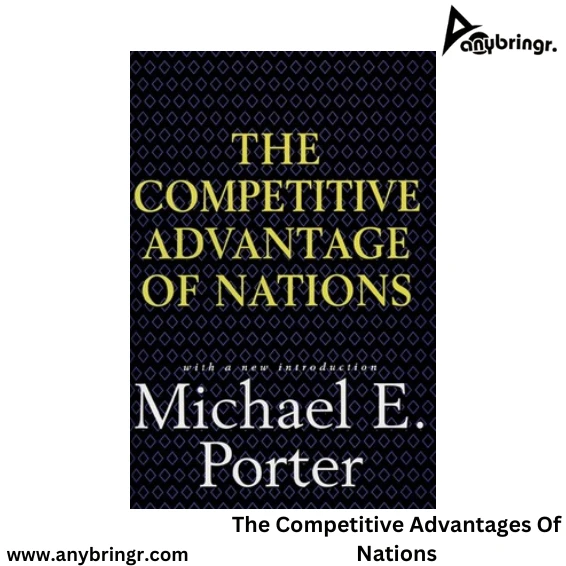

The Competitive Advantage of Nations by Michael Porter |
The Competitive Advantage of Nations by Michael Porter is a landmark book that explores why some nations succeed in global markets while others fail. Porter introduces the Diamond Model, which identifies key factors like innovation .......
Books
0.0 ( 0 review)
Product Description
Amazon Link The Competitive Advantage of Nations : was introduced by economist Michael Porter in his influential 1990 book titled The Competitive Advantage of Nations . Porter developed this concept as a way to explain why some nations or regions excel in certain industries or sectors, while others do not. According to Porter, the competitive advantage of a nation depends on its ability to create an environment that fosters the innovation, productivity, and success of industries within that nation.
Porter's Diamond Model
Porter proposed the Diamond Model to explain the factors that contribute to a nation's competitive advantage. The model consists of four interrelated components :
1. Factor Conditions :
This refers to a nation's ability to develop and maintain resources (both basic and advanced) such as skilled labor, infrastructure, and technological know how. Advanced factors, like innovation and specialized skills, provide long term competitive advantages.
2. Demand Conditions :
The nature of domestic demand for a nation's goods or services affects how industries respond and innovate. A sophisticated and demanding local market forces companies to continually improve and push for innovation, which gives them a competitive edge in international markets.
3. Related and Supporting Industries :
Competitive industries tend to cluster together. Strong, efficient supplier networks and related industries can enhance innovation and lower costs. For example, a thriving automobile industry often relies on strong local steel, parts, and technology sectors.
4. Firm Strategy, Structure, and Rivalry :
The way companies are structured, managed, and compete in a nation also shapes competitiveness. Intense domestic competition pushes firms to innovate, reduce costs, and become more efficient, which makes them stronger globally.
Two Additional Factors :
Porter also highlighted two additional elements that influence national competitive advantage:
- Government :
Government policies can either support or hinder national competitive advantage. By investing in education, infrastructure, and R&D or by enforcing regulations that encourage competition and innovation, governments play a critical role.
- Chance :
Unpredictable events like breakthroughs in technology, political shifts, or natural disasters can create opportunities for industries in certain nations to gain competitive advantages.
Key Takeaways :
- The competitive advantage of a nation lies in its ability to foster innovation, create conducive environments for industries, and continually improve resources and skills.
- No single factor explains national competitive advantage; it is the interplay of various elements (the "diamond") that determines success.
- Nations and firms that adapt to changes, innovate, and meet high local demands often thrive on the global stage.
This model contrasts with traditional theories of comparative advantage, which suggest that nations should focus on industries where they naturally have the most resources. Instead, Porter argues that nations can develop advantages in industries where they previously had none through strategy and innovation.
Reviews :
BusinessWeek :
Packed with valuable insights into why industries, regions, and nations thrive or falter. A must read for understanding economic success.
The Economist :
Porter delivers a comprehensive perspective on global economic shifts, offering a powerful analytical framework. His work on capitalism is as groundbreaking as Marx’s views on class struggle a truly remarkable achievement.
Administrative Science Quarterly :
This book is set to deeply influence academic studies, shift how managers approach strategy, and reshape public policy thinking.
Business in a Contemporary World :
The Competitive Advantage of Nations is on its way to becoming a timeless reference in the field of global economics and business strategy.
Journal of Development Economics :
Porter’s work marks the first substantial effort to create a truly original theory of national economic development since the postwar era, providing one of the most innovative approaches to thinking about development policy in years.
Publishers Weekly :
This vast and impressive work is thoughtfully structured, making it accessible for business leaders, economists, policymakers, and general readers alike, allowing them to easily navigate the sections most relevant to their needs.
Author Boigraphy :
Michael Eugene Porter (born May 23, 1947) is a leading authority on competitive strategy, economic development, and the application of business principles to social issues like health care and the environment. He is a professor at Harvard Business School and a globally recognized academic, known for his groundbreaking work on competitive advantage, industry analysis, and economic clusters.
Early Life and Education :
Porter was born in Ann Arbor, Michigan , and grew up in the suburbs of New Jersey. His father was a civil engineer, which influenced Porter’s interest in applied sciences. He excelled academically and athletically during his school years, especially in baseball and golf .
Porter earned a B.S.E. in aerospace and mechanical engineering from Princeton University in 1969. He then went on to study at Harvard Business School , where he earned an MBA with high distinction in 1971. He later completed a Ph.D. in Business Economics from Harvard University in 1973.
Academic Career :
Michael Porter began teaching at Harvard Business School shortly after completing his Ph.D. and quickly became one of the most influential thinkers in the field of business strategy. Over the years, his work has fundamentally reshaped how businesses and governments think about competitive strategy and national competitiveness.
Major Contributions :
1. Competitive Strategy : Porter's book Competitive Strategy : Techniques for Analyzing Industries and Competitors (1980) revolutionized how companies approach competition. He introduced the Five Forces Framework , which analyzes the competitive forces that shape industry profitability. These forces include the threat of new entrants, bargaining power of suppliers, bargaining power of customers, threat of substitute products, and rivalry among existing competitors.
2. Competitive Advantage : In his seminal work The Competitive Advantage of Nations (1990), Porter developed the Diamond Model , which explains how nations achieve competitive advantage in particular industries. The book laid the foundation for modern theories of economic clusters and regional competitiveness.
3. Value Chain Analysis : Porter introduced the concept of the value chain in Competitive Advantage : Creating and Sustaining Superior Performance (1985). It describes how a company’s internal activities can be analyzed to optimize efficiency and create competitive advantages.
4. Clusters and Regional Development : Porter popularized the idea of economic geographic concentrations of interconnected businesses and institutions that drive innovation and economic performance. He demonstrated how clusters contribute to national and regional economic growth.
5. Shared Value : Porter, along with co author Mark Kramer, introduced the concept of creating shared value (CSV in 2011. This idea suggests that businesses can generate economic value by addressing societal challenges, thereby fostering both financial success and positive social impact.
Other Contributions :
Porter’s work goes beyond business strategy. He has applied his analytical frameworks to address broader societal issues such as health care, environmental sustainability, and poverty. He co founded organizations like the Institute for Strategy and Competitiveness at Harvard, and his work has influenced governments, NGOs, and businesses worldwide.
Porter has advised many national governments and corporations, including the U.S. government , where he played a role in shaping economic development strategies. He has also received numerous awards and honors, including several honorary degrees and recognition as one of the most influential thinkers in business by publications such as The Economist and Harvard Business Review .
Personal Life :
Michael Porter is married to Debra Lerner , a professor and researcher in health care policy. They have three daughters. Outside of academia, Porter remains passionate about sports, particularly golf, which he played competitively during his youth.
Legacy :
Porter’s contributions to business strategy, economic development, and public policy have earned him a lasting reputation as one of the most influential management thinkers of the 20th and 21st centuries. His frameworks such as the Five Forces and Diamond Model are used worldwide by businesses, policymakers, and academics to analyze competition and drive strategic decisions.
Product details :
- Publisher : Free Press (June 1, 1998)
- Language : English
- Hardcover : 896 pages
- ISBN-10 : 0684841479
- ISBN-13 : 978-0684841472
- Item Weight : 2.75 pounds
- Dimensions : 6.13 x 1.7 x 9.25 inches
Share your feedback about this product
Your email address will not be published. Required fields are marked *
Rate this product: *
reviews
No Review available for this product
